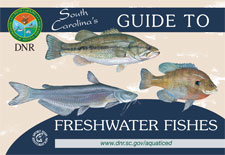Freshwater Fish - Species
Atlantic sturgeon
Freshwater Fishing License required.
Regulations
It is illegal to harm, kill or possess Atlantic sturgeon. They are federally listed as an endangered species. A sturgeon caught must be returned immediately to the waters from where it was taken.
Atlantic sturgeon (Acipenser oxyrinchus) - Native
Description: (Anatomy of a Fish)
Atlantic sturgeon have dark bronze to brown sides that fade to lighter browns on the sides with a white belly. The Atlantic sturgeon has a small mouth with a relatively pointed snout. Large individuals can have a blunted snout. There are a row of two to six small bony plates, or scutes between the base of the anal fin and the midlateral row of scutes. Atlantic sturgeon have small mouths; the inner gape width (measured between the inside corner of the lips) is usually less than 60% of the interorbital width. A row of two to six small bony plates, or scutes, is present between the base of the anal fin and the midlateral row of scutes. Body coloration is dark bronze to brown above, lighter on the side, and white below. The lining of the body cavity and the intestine is pale. The Atlantic sturgeon has a pointed snout and a narrow mouth; however, the snout can be relatively blunt in large individuals. In the adult the distance from the tip of the snout to the anterior edge of the upper lips is about twice that of the width of the outer gape (measured across the outer edges of the lips).
Range: All major river drainages, mostly in the river mainstems and on the coast.
Average Length: 3 to 14 feet
Average Size: Up to 800 lbs
South Carolina State Record: Unknown
Life Expectancy: Approximately 30 years
Preferred Habitat
Atlantic sturgeon are diadromous, spending its first few years of life in fresh or brackish water of large rivers and then migrating to the ocean to mature. In South Carolina, adult Atlantic sturgeons occur in most rivers and estuaries along the coast.
Food Habits
- They are bottom feeders feeding on aquatic insects, amphipods, isopods, shrimp, mollusks and even some fishes that live in the substrate.
Spawning
- Spawning has been documented in both the fall and spring in South Carolina with spawning occurring in the Pee Dee, Edisto, Combahee, Savannah rivers and possibly the Waccamaw River.
- Dams impede natural spawning migrations on the Santee and Cooper Rivers but studies indicate that populations may reproduce below the dams.
Miscellaneous
Atlantic sturgeons are the largest fish living in freshwater on the entire Atlantic coast. During the mid-1970s, half of the US landings of this species came from South Carolina, in particular in Winyah Bay. The fishery for this species in South Carolina was closed in 1985 and other Atlantic States. The Atlantic sturgeon is federally listed as an endangered species.
Commonly Mistaken Species
One species of fish that is commonly mistaken for this species:
Literature Cited
Rohde, Fred C, Arndt, Rudolf G., Foltz, Jeffery W., Quattro, Joseph M. 2009. Freshwater Fishes of South Carolina. University of South Carolina Press, Columbia, South Carolina.
Wildlife and Freshwater Fisheries Division. 2009. South Carolina Guide to Freshwater Fishes.
Fish Illustration by Duane Raver.


